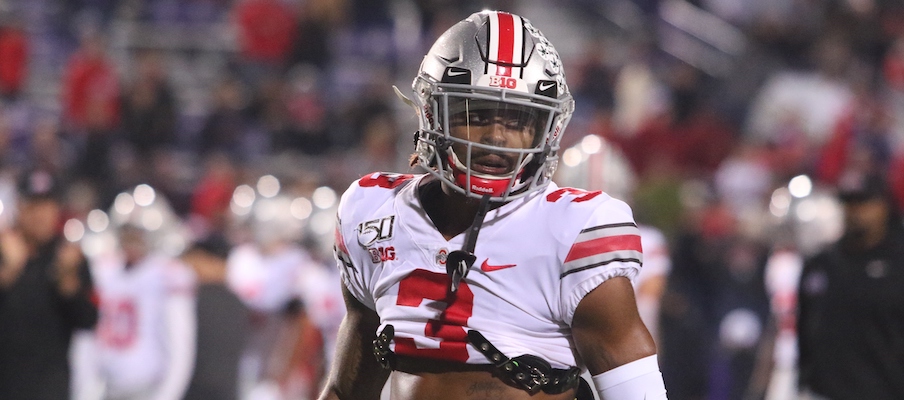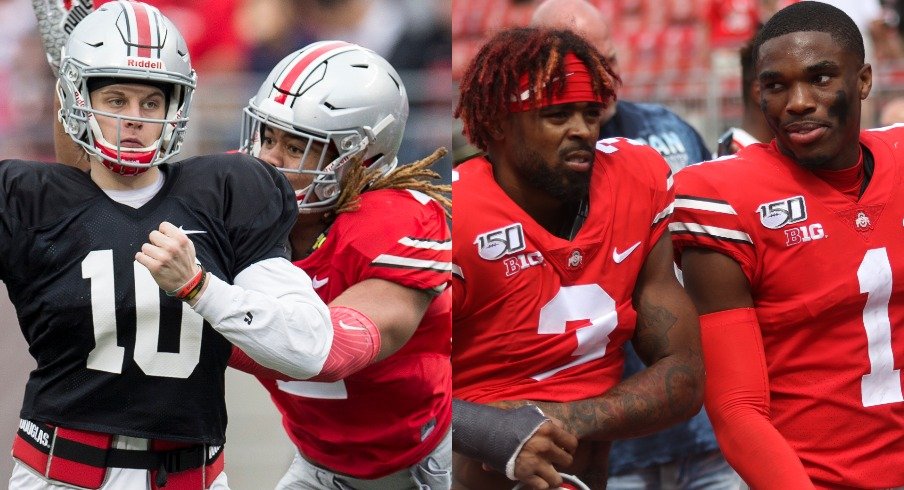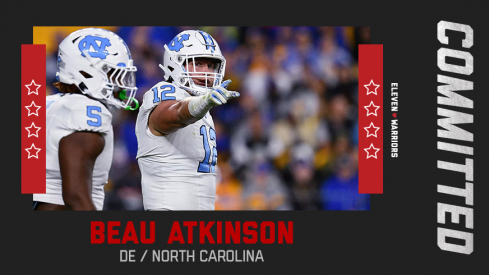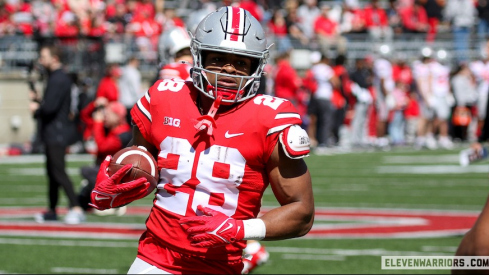No one would have been surprised a year ago to find out that Chase Young and Jeff Okudah would be top-three overall picks in the 2020 NFL draft. For that matter, no one would have been surprised three years ago.
Finding out that Joe Burrow would be the No. 1 overall pick in the 2020 NFL draft, and that Damon Arnette would be selected in the top 20? Yeah, that would have turned some heads.
Young and Okudah were expected to be future first-round NFL draft picks since back when they were the No. 7 and No. 8 overall prospects in the recruiting class of 2017. Both of them arrived at Ohio State with superstar potential and made the progression they were expected to make during their three years in Columbus. After playing occasionally as freshmen, both showed flashes of greatness as sophomores before putting it all together with unanimous All-American junior seasons that set them up to be the first two defensive players off the board in this year’s NFL draft.
That doesn’t make what they accomplished at Ohio State, or what they accomplished on Thursday night, any less impressive. Becoming a top-three overall NFL draft pick, like the Washington Redskins made Young and the Detroit Lions made Okudah, takes a lot more than just physical talent.
Their hard work over the past three years, combined with the tutelage of coaches like Larry Johnson for Young and Jeff Hafley and Kerry Coombs for Okudah, allowed them to maximize their talent and become the first two players selected from their recruiting class. Among the 33 composite five-star prospects in the class of 2017, only four of them were selected in Thursday’s first round, and Young and Okudah were the only two who were top-15 overall prospects out of high school.
“Guys who just have so much talent and are blessed, but then it comes together with discipline and skill and technique, and that’s what happened for both of these guys,” Ohio State coach Ryan Day said during an interview on ESPN’s SportsCenter after Thursday night’s first round. “They really got serious this last year and being three years in our program, it starts to show. Discipline and skill now is off the charts, and now you got something special.”
If Young and Okudah hadn’t played the way they did during Ohio State’s 2019 season, they wouldn’t have been the No. 2 and No. 3 overall picks in the 2020 NFL draft. But it’s no surprise that they played that well or that they ended up where they did. After all, both of them were being projected as first-round picks even before last season began.
The same cannot be said for Arnette, who likely wouldn’t have been selected before the middle rounds if he had entered the 2019 NFL draft, which he nearly did before a call from Pro Football Hall of Fame wide receiver Cris Carter convinced him to stay at Ohio State for one final year.
Arnette wasn’t a highly touted recruit – he was ranked as the No. 653 overall prospect in the class of 2015 – and in his first three playing seasons at Ohio State, he didn’t perform like a first-round pick. Although he demonstrated pro-caliber traits and flashes of brilliance, his game was plagued by too much inconsistency in his earlier seasons as a Buckeye to think he would have been an early-round NFL draft pick a year ago.
Under the tutelage of Hafley in 2019, though, Arnette finally showed that he could play at an elite level week in and week out – all the while demonstrating toughness by playing the entire season with a cast on his broken right wrist – which is why the Las Vegas Raiders ultimately chose to select him with the No. 19 overall pick in this year’s draft.
Even on Thursday night, it came as a surprise to many – though Ohio State defensive coordinator Kerry Coombs had warned us one day earlier that we shouldn’t be surprised – that Arnette was a top-20 pick. But the outcome was a testament to how there are many different paths that can lead to a first-round NFL draft selection.
Few would have projected that Arnette would be a first-round pick when he arrived at Ohio State as a three-star recruit, and for most of his Buckeye career, he didn't appear to be on the verge of becoming one. But by staying the course, overcoming setbacks and ultimately finishing his collegiate career strong, Arnette emerged as one of the 2020 draft’s top cornerbacks, serving as yet another example of how Ohio State can help a player achieve even the loftiest of NFL dreams.

The same can be said for Burrow, though his path to becoming the Cincinnati Bengals’ choice with this year’s top pick featured even more forks in the road.
Ranked as the No. 280 overall recruit in the class of 2015, Burrow didn’t stand out as a likely future NFL quarterback when he arrived at Ohio State. He never started a game in his three seasons at Ohio State, forcing him to leave Ohio State to guarantee he would have an opportunity to start after he fell behind Dwayne Haskins – who was perceived to have higher NFL upside at the time – in the Buckeyes’ 2018 quarterback competition.
Even after his first season at LSU, in which he completed just 57.6 percent of his passing attempts for 2,894 yards and 16 touchdowns, Burrow was only projected to be a middle-round pick at best in this year’s NFL draft. During an interview with ESPN’s Suzy Kolber on Thursday night, Burrow admitted himself that he wasn’t an early round-caliber player at this time a year ago.
“I wasn’t very good my junior year,” Burrow said. “But I worked really, really hard to improve.”
And improve he did, as Burrow had one of the greatest seasons ever for a collegiate quarterback in 2019, completing 76.3 percent of his passing attempts for 5,671 yards and 60 touchdowns with only six interceptions, demonstrating all the tools to be an NFL franchise quarterback all the while leading LSU to a national championship.
Despite never getting to show it at Ohio State, the talent that Urban Meyer and Tom Herman believed Burrow had in recruiting him to Ohio State ultimately blossomed in his fifth and final year as a college football player. And Burrow has repeatedly expressed gratitude to Ohio State for playing a key role in his development that enabled him to become the premier quarterback in this year’s draft class and the only player who would be drafted ahead of Young and Okudah.
Even Burrow himself, though, couldn’t have imagined a year ago that he’d be the No. 1 overall pick in the NFL draft.
“I would’ve told you you were crazy,” Burrow said. “To jump up to No. 1 overall is crazy to me. But it’s a dream come true.”
Now more than ever, Ohio State is pursuing the top recruits from all over the country, the five-star prospects like Okudah and Young who can be projected as potential first-round NFL draft picks before they even finish high school. But Ohio State also recruits plenty of players who aren’t five-star prospects, and many players who go on to lead teams to national championships and become top NFL draftees – even if it takes them a little longer to get there – aren’t five-star prospects either.
Any prospect as talented as Young or Okudah has the potential to accomplish what they did if they’re developed properly at the collegiate level. Yet it’s the less predictable success of players like Arnette, and even Burrow, that might be more telling to what Ohio State can help a player become, and might be the stories the Buckeyes really should tell to recruit new players into the program and motivate their current players to stay the course.
“There’s so much that goes into a night like this, and it starts off in the recruiting process,” Day said. “Going into families’ living rooms and talking to them about our program, and this is the dream. And when you take tonight, you see guys on different journeys, but it’s a combination of potential and talent mixed in with development, and it’s just, it’s a great night. We’re so happy to be a part of it.”
Joe Burrow/Chase Young photo by Greg Bartram – USA TODAY Sports


